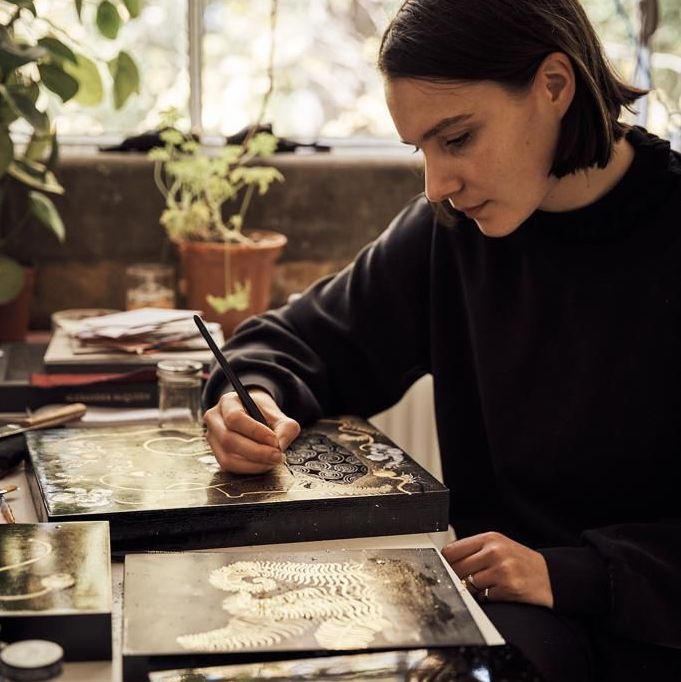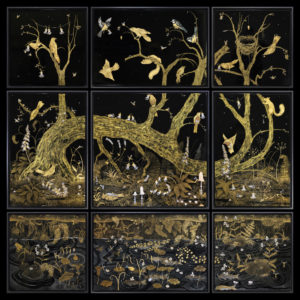
Small Worlds: On Beatrix Potter and Tuesday Riddell
by Anna Souter
In 1896, Beatrix Potter wrote in her diary: “We as outsiders express a pleasing, fresh irreverence for leading botanical authorities, it really does seem very impertinent, but the [facts] are there. It may just be that one sees them because one has an open mind, not in a groove.” Potter believed that working outside the academic tradition and scientific institutions afforded her greater independence of thought and a clearer understanding of flora and fauna; escaping the constraints experienced by the “authorities”, Potter was able to look with an “open mind” to the wonderful possibilities of the natural world.
Of course, working independently was Potter’s only option. When her uncle contrived to show some of her illustrations of fungi to botanists at Kew Gardens, her work was dismissed due to her age and gender; the resident scientists were sceptical that someone in Potters’ position could have come up with plausible theories based on experiments conducted without guidance and in an amateur setting. However, many of the ideas she expresses through her illustrations, such as the symbiotic relationships between many fungi and algal species, are now considered to be more advanced than the botanical knowledge widely held by the male gatekeepers of the science at the time.
Potter did manage to get a (now sadly lost) paper, “On the Germination of the Species of Agaricineae”, read at the Linnean Society soon after this rejection – albeit by a third party as women were not allowed to attend. However, since it seemed impossible that she would gain proper recognition or any degree of financial independence from her work as a naturalist, Potter turned to children’s books, combining narrative and illustration in publications that remain well-loved to this day.
Potter’s illustrative work is unique in how it combines the scientific accuracy of an experienced naturalist with the whimsical inventions of an artist who understands how to appeal to the child’s imagination. Her genius was to dress zoologically correct animals in human clothes, based on a lifetime of study at home and outdoors. For example, when Potter’s publisher complained that the mottled legs emerging from Jeremy Fisher’s red tailcoat and embroidered waistcoat were too yellow, Potter marched over to the offices of Frederick Warne & Co with her pet frog Punch in a jam jar to prove the accuracy of her drawings. She was determined that her books should be lessons in natural history as well as entertainment.
 For artist Tuesday Riddell, Beatrix Potter’s small worlds represent a radical continuity between the magical and the real, where close observation of landscapes and ecosystems runs smoothly into a profound re-enchantment with the more-than-human. For Riddell, as for Potter, gaining an intimate knowledge of another being does not strip it of its personhood or its animacy, but rather enhances these qualities and offers a doorway into an imaginative empathy and sense of wonder.
For artist Tuesday Riddell, Beatrix Potter’s small worlds represent a radical continuity between the magical and the real, where close observation of landscapes and ecosystems runs smoothly into a profound re-enchantment with the more-than-human. For Riddell, as for Potter, gaining an intimate knowledge of another being does not strip it of its personhood or its animacy, but rather enhances these qualities and offers a doorway into an imaginative empathy and sense of wonder.
Much of Riddell’s work is closely inspired by the illustrations of animal worlds she encountered in the books of her childhood, with a particular emphasis on the work of Beatrix Potter. Riddell’s images explore the interconnected lives of fungi, insects, birds, and mammals, often in the context of the forest floor or the banks of a body of water. Many of her shimmering, multi-layered images are set in the mysterious hours of darkness and twilight, suggesting a realm of imagined animal encounters, where secret gatherings take place in the absence of human watchers. Like Potter, Riddell creates spaces and relationships which are both fantastical and natural.
Riddell works with japanning, a technique originally developed in the 17th century as an imitation of Asian lacquer work. She learned the process at City & Guilds Art School as part of the Painter-Stainers’ decorative surfaces fellowship, which provides students with specialist training in endangered crafts. For each work, Riddell starts by sanding and polishing a wooden board, before applying between 25 and 30 layers of European lacquer with a brush. The brush marks are removed by sanding and polishing the surface of the lacquer between every three layers.
After the lacquer has cured to a black, mirrored surface, the artist begins to mark out the central composition, which she usually sketches straight onto the board without extensive pre-planning. She marks out key silhouettes of plants, animals, and insects, before using lustre powders to develop the background. She then fills in the silhouettes using pigmented shading and adds detail using gold and silver leaf. Finally, the whole piece is sealed with a layer of shellac or varnish.
For Riddell, there is a parallel to be drawn between endangered crafts and endangered species, and her work attempts to draw attention to both. Her work is as much concerned with the natural world as it is with processes of making; in the midst of the ecological crisis, the delicate, intricate japanning technique reflects the fragility of our ecosystems and our complex relationship with the natural world.
The central work in Tuesday Riddell’s solo presentation at Messum’s London is directly inspired by a visit to Beatrix Potter’s farm, Hilltop, in the Lake District. On a walk through the surrounding countryside, Riddell came across a tree that had fallen beside a small stream, crossing it like a bridge. The tree had begun to sprout new branches growing upwards, resiliently reclaiming vertical growth despite falling to a horizontal position.
Riddell has populated her version of this bowed and twisted – but lively – tree with an ensemble cast of birds, mammals, insects, plants, and mushrooms. These protagonists interact with and respond to each other: blue tits carry off the bell-shaped flowers of a foxglove; a moth rests on the spongey cap of a mushroom; a cocooned caterpillar hangs above a bird’s nest like a baby’s mobile. Although Riddell’s animals are not anthropomorphised in the same way as Potter’s, she similarly allows miniature narratives to emerge within this microcosm, hinting at distinct relationships and personalities among her nonhuman characters.
Riddell’s process involves close observation of wildlife, often in the urban parks, gardens, and waysides surrounding her London home. After absorbing information and picking out small details, she returns to the studio and begins sketching, often drawing directly onto a meticulously prepared gleaming panel. The artist demonstrates an astonishing ability to capture the nuances of other species through working primarily from memory and the imagination.
There is a theatrical quality to Riddell’s work, which combines the naturalistic with the aestheticized in a way that is inspired by the stylised illustrations of children’s books. As in many fairy tales and Victorian stories for children, Riddell’s images contain a potent element of darkness. Her works often incorporate small scenes of conflict, death, or decay, belying initial impressions of perfect harmony. They speak to a widespread sense of unease over the uncanny indifference of nonhuman nature towards human ethics and morality. This can be found, too, in the writings of Beatrix Potter; to the discomfort of many contemporary parents, Potter’s smartly-dressed animals have not been stripped of their natural desire to eat each other, creating conflicts that are resolved only through escape rather than through compromise or moral revelations, as we might expect from children’s stories today.
The shimmering, multifaceted layers of Riddell’s japanned panels appear to shapeshift according to the angle and lighting. This constant metamorphosis infuses the works with a feeling of magic, conjuring another realm hidden a hair’s breadth from our own. Like Beatrix Potter, Riddell shows that there is an enchantment to be found in the comings and goings of everyday nature, from the scamperings of mice to the burrowings of earthworms, from the iridescent flash of a dragonfly’s wing to the quiet rotting of a fallen apple.
For both artists, close observation of the more-than-human is most effective when combined with the radical power of storytelling and the imagination. Riddell’s gleaming, mysterious works speak to the importance of looking at nature with what Beatrix Potter called an “open mind”: a receptiveness to the compelling blend of beauty and horror present in those small worlds that thrive alongside our own, if only we can take the time and look closely enough to notice them.
–
Bibliography:
Annemarie Bilclough (ed.), Beatrix Potter: Drawn to Nature (London, 2022)
Catherine Golden, “Beatrix Potter: Naturalist Artist” in Woman’s Art Journal, Vol. 11, No. 1 (Spring -Summer, 1990), 16-20
Rudolf Schmid, “Beatrix Potter [1866-1943] as a Mycologist: The Period before Peter Rabbit and Friends” in Taxon, Vol. 48, No. 2 (May, 1999), 438-443